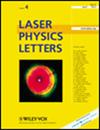Visualizing the quantum phase transition by using quantum steering ellipsoids in the anisotropic spin XY model
IF 1.4
4区 物理与天体物理
Q3 OPTICS
引用次数: 0
Abstract
Quantum steering ellipsoids (QSEs) can serve as a useful geometric tool for describing both the strength and type of quantum correlations between two subsystems of a compound system. By employing the quantum renormalization-group method, we focus on investigating the relation between QSEs and the quantum phase transition (QPT) in the anisotropic spin XY model. The results indicate that the QPT is well visualized in terms of the shape of the QSE, i.e. it is an oblate spheroid in the spin-fluid phase and a needle in the Néel phase. Meanwhile, after several iterations of renormalization, the QSE volume V undergoes a contraction mutation, and can develop two saturated values at the critical points associated with the QPT, which correspond to two different phases: the spin-fluid phase and the Néel phase. We also find that the QSE is closely associated with quantum entanglement in the model, i.e. the volume of the QSE between blocks is more than 4π/81 when the system is in the spin-fluid phase, which indicates that the system must be entangled. Furthermore, the nonanalytic and scaling behaviors of the volume of the QSE have been analyzed in detail, and the results convince us that the quantum critical properties are connected with the behavior of the QSE.在各向异性自旋 XY 模型中利用量子转向椭球使量子相变可视化
量子转向椭球体(QSE)可以作为一种有用的几何工具,用来描述复合系统两个子系统之间量子关联的强度和类型。通过采用量子重正化群方法,我们重点研究了各向异性自旋 XY 模型中 QSE 与量子相变(QPT)之间的关系。结果表明,QPT 可以很好地从 QSE 的形状上直观地表现出来,即在自旋流体相中是一个扁球形,而在奈尔相中是一个针形。同时,经过多次重正化迭代后,QSE 的体积 V 会发生收缩突变,并在与 QPT 相关的临界点形成两个饱和值,分别对应于两个不同的阶段:自旋流体阶段和奈尔阶段。我们还发现,模型中的 QSE 与量子纠缠密切相关,即当系统处于自旋流体相时,块间 QSE 的体积大于 4π/81,这表明系统一定是纠缠的。此外,我们还详细分析了 QSE 体积的非解析行为和缩放行为,结果使我们确信量子临界特性与 QSE 行为有关。
本文章由计算机程序翻译,如有差异,请以英文原文为准。
求助全文
约1分钟内获得全文
求助全文
来源期刊

Laser Physics Letters
物理-仪器仪表
CiteScore
3.30
自引率
11.80%
发文量
174
审稿时长
2.4 months
期刊介绍:
Laser Physics Letters encompasses all aspects of laser physics sciences including, inter alia, spectroscopy, quantum electronics, quantum optics, quantum electrodynamics, nonlinear optics, atom optics, quantum computation, quantum information processing and storage, fiber optics and their applications in chemistry, biology, engineering and medicine.
The full list of subject areas covered is as follows:
-physics of lasers-
fibre optics and fibre lasers-
quantum optics and quantum information science-
ultrafast optics and strong-field physics-
nonlinear optics-
physics of cold trapped atoms-
laser methods in chemistry, biology, medicine and ecology-
laser spectroscopy-
novel laser materials and lasers-
optics of nanomaterials-
interaction of laser radiation with matter-
laser interaction with solids-
photonics
 求助内容:
求助内容: 应助结果提醒方式:
应助结果提醒方式:


